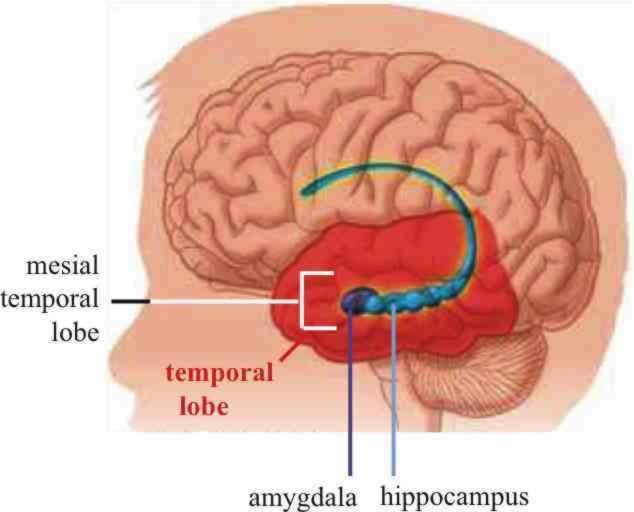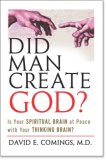Penfield’s brain mapping studies clearly placed both temporal lobes front and center as the site for many complex spiritual experiences including the re-playing of past experiences, thought intrusions, feelings of déjá vu, out of body sensations, trances, or fugue states, automatic behaviors, feelings of being in the presence of others, of hearing music, of hearing angelic voices, of intense meaningfulness, of being connected to some force greater than themselves, and of talking to God.
The spiritual brain

In the previous chapters we have seen that specific brain areas are involved in consciousness, thinking and rational thought (the rational brain), pleasure (the pleasure brain), and societal interactions (the social brain). Is there also a spiritual brain, a neural location for feelings of spirituality, feelings of being connected to something larger than ourselves, feelings of immortality, feelings that we are special, and feelings that God is talking just to us? The answer is yes. This chapter reviews the evidence suggesting that the temporal lobes represent the neural location for spirituality. [p335]
Wilder Penfield and Mapping of the Spiritual Human Brain
Just as consciousness and the “soul” are brain based, so are spiritual and religious experiences. The evidence for this began with the studies by the famous Canadian neurosurgeon, Wilder Penfield….A unique advantage of surgery on the brain is that the brain has no pain receptors. It is thus possible to perform surgery on conscious, talking patients….Taking advantage of this unique opportunity and as a part of the process in identifying the lesions causing temporal lobe epilepsy, Penfield began a systemic process of electrically stimulating different parts of the brain and recording the verbal responses in conscious subjects. [p338]
Spiritual and Religious Experiences and Temporal Lobe Epilepsy (TLE) The most fascinating part of TLE is the nature of the spiritual and religious feelings that may occur during the seizures and of the personality changes that often occur between the seizures.There have been many reports of spiritual and religious experiences associated with TLE. [p345]
Dostoevsky. Fyodor Dostoevsky, the famous Russian novelist, also appears to have had musicogenic TLE. The following is an account of a friend relating an argument that Dostoevsky, a believer, was engaged in with an atheist: "God exists, He exists," Dostoevsky finally cried, beside himself with excitement. At that same moment, the bells of the neighboring church rang for Easter matins. The air was vibrant and full of sound, "And I felt," Fyodor narrates, "that heavens have come down to earth and absorbed me. I really perceived God and was imbued with him. Yes, God exists..I cried.and I do not remember any more." [p354]
Temporal lobe epilepsy and its spiritual manifestations may have played a major role in the religious conversions of many historical figures and in the origin of several religions. [p356]
Near Death Experiences Some individuals who have come very close to dying, or who have been clinically dead for varying periods of time, report profound spiritual sensations and feelings. After they recover they often report significant changes in their attitude about God, religion, death, and personal relationships. [p356] When Melvin Morse re-interviewed the parents of children with NDE eight years later, he found these children had become special teenagers who had excellent relationships with their families. They seemed to share a maturity and wisdom that was humbling. There was a conspicuous absence of drug abuse and even experimentation. There was little rebellion against authority, no excessive risk taking, and no teenage pregnancies. They had good grades. One child described himself as more serious than his peers, but a lot happier. One girl said she saw life differently than most people. Little things that bother others did not bother her. She felt calmer and more in control. Her mother described her as "serene" and "very mature for her age." As with others in the study she did not fear death, but wanted to make sure she "lives life to the fullest." Morse felt that the right temporal lobes were the site of the positive aspects of NDEs. [p357]
Individuals with near-death experiences (NDE) have many features with a strong spiritual content including a feeling of great peace, depersonalization or out of body sensations, changes in visual perception interpreted as passing down a dark tunnel and coming out into a bright light, a review of one's life, and a feeling of seeing God and being in heaven. As with other forms of spiritual awakening, NDEs are often associated with a permanent decrease in an individual's susceptibility to depression and fear of death, improved overall mental health, increased tolerance of stress, and a greater appreciation for the spiritual aspects of life. [p363]
As much as some would like to use NDEs as proof that God, heaven and a life-after-death exists, NDEs are most likely due to severe lack of oxygen to the brain, especially the temporal lobes..This biological explanation in no way detracts from the power of NDEs to produce life long spiritual changes. [p364]
DMT and Spirituality. In 1990, Dr. Rich Strassman, a clinical psychiatrist a the University of New Mexico, obtained permission from the Drug Enforcement Agency (DEA) and other regulatory agencies to study the effects of di-methyl-tryptamine or DMT in human volunteers. He summarized these results in his book DMT The Spirit Molecule.
The psychedelic drugs like DMT often produce a sensation of "contact," of being in the presence of and interacting with a non-human being. Highly intelligent and sophisticated test subjects who knew these feelings were drug induced nevertheless insisted the contact had really happened. The temporal lobe-limbic system's emotional tape recorder sometimes cannot distinguish between externally generated real events and internally generated factitional experience thus providing a system in which the rational brain and the spiritual brain are not necessarily in conflict. It is simply necessary for the rational brain to understand that one of the characteristics of the spiritual brain is to strongly believe in something, have faith in something, even when the rational brain says it is unreasonable or that it did not and could not have happened. [p373]
It is also little wonder that psychedelic drugs have also been called entheogens meaning God-containing.
DMT is made in the human brain and has been referred to as the Spirit Molecule. When given intravenously it produces a wide range of visual and auditory psychedelic and spiritual experiences that have many features in common with OBE, NDEs, alien abductions, depersonalization, derealization, "contact" with other beings, and other spiritual phenomena. Like LSD it appears to exert its effect by inhibiting serotonin receptors in the temporal lobes. The release of this endogenous psychedelic compound during periods of stress and other conditions could play a role in generating spiritual experiences. [p374]
The Temporolimbic Marker Model of Saver and Rabin. Saver and Rabin proposed a temporolimbic marker model of spirituality. The name temporolimbic is based on the fact that while the amygdala and the hippocampus, and the emotional memories they contain, are part of the temporal lobes, they are also part of the limbic system. They play a critical role in spiritual experiences produced by brain stimulation, temporal lobe seizures, auras, NDEs and psychedelic drugs.
The temporolimbic system consists of the temporal lobes and the amygdala and hippocampal portion of the limbic system. The latter two structures serve as the site of emotional memory. Different studies show that a wide range factors that influence temporal lobe function can produce hallucinations, paranormal, spiritual, mystical, and religious experiences. These factors include the electrical stimulation of the temporal lobes; spontaneous temporal lobe epileptic auras and seizures; trauma; the severe anoxia of near death, G-forces and carbon dioxide inhalation; psychedelic drugs; speaking in tongues; and many environmental stressors. In addition, the superior temporal gyrus, the hippocampus, and the surrounding ectorhinal cortex have been shown to be the site of a sense of the self in space. Aberrant functioning of this area can result in the out of body sensations, depersonalization and derealization so common in spiritual and mystical experiences. These spiritual experiences are seen as similar to those of ordinary experiences except that they are tagged by the limbic system as of profound importance, meaningful, immensely joyous and of providing a sense of being connected to something greater than ourselves. [p385]
